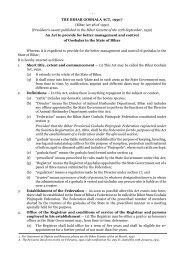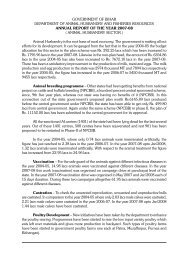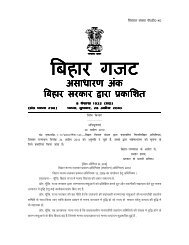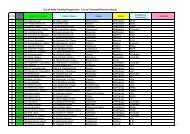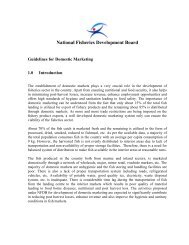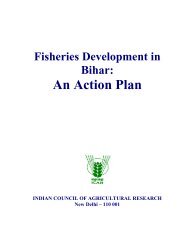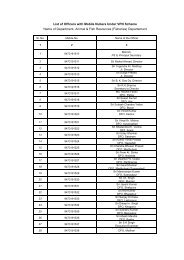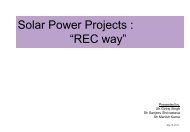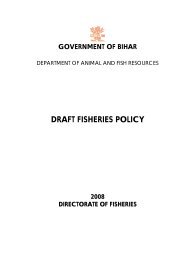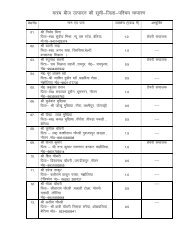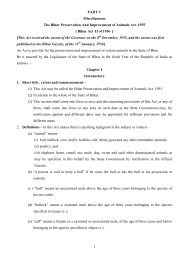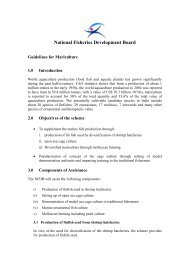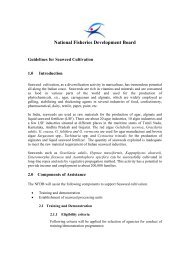National Fisheries Development Board - Animal & Fish Resources
National Fisheries Development Board - Animal & Fish Resources
National Fisheries Development Board - Animal & Fish Resources
You also want an ePaper? Increase the reach of your titles
YUMPU automatically turns print PDFs into web optimized ePapers that Google loves.
The Central Institute of <strong><strong>Fish</strong>eries</strong> Nautical Engineering and Training (CIFNET), Kochiconducts an 18 month Mate <strong>Fish</strong>ing Vessel Course (MFVC). The trainees after completing thiscourse are required to undergo 24 months sea service, which can be completed in either aGovernment fishing vessel (e.g. those of FSI) or a private-owned fishing vessel. These traineescan also form an ideal pool of candidates who could be trained in tuna fishing and some ofthem may later also serve as trainers.The <strong>Board</strong> may cooperate with the CIFNET and the Association of <strong>Fish</strong>ing Industries (AFI),Visakhapatnam to prepare the training calendar and curriculum. The premises of CIFNET andthe FSI on both the east (Visakhapatnam, Chennai) and west coasts (Cochin, Goa, Porbandar))could be used for training and the CIFNET and the AFI may coordinate the trainingprogramme on behalf of the NFDB. The agencies assisting NFDB in this regard could bereimbursed the cost that would be incurred for coordination, etc. The other trainees could besponsored by the industry on a regular basis.3.3 <strong>Development</strong> of shore-based infrastructureMaintenance of adequate levels of hygiene and sanitation at all stages of harvesting and postharvestis of utmost importance if tuna is to be marketed in sashimi grade. In this regard themaintenance of fishing harbours/ fish landing centers (FLCs) becomes critical and cannot beoverlooked. Presently, the fishing harbours at Visakhapatnam, Chennai, Cochin and Mumbaihandle the bulk of tuna landings. It is, therefore, essential that these harbours and also thosewhere tuna landings might increase substantially in the near future (e.g. Goa, Pondicherry,Vanakbara, etc) should be renovated to ensure that that have the optimum levels of hygieneand sanitation and all other facilities that is required for quick handling of the catch before it iseither sent to the processing unit or packed for export. If possible, the provision of dedicatedjetties for tuna landings could also be considered in these harbours to minimize the risks ofcontamination and facilitate quick handling.The NFDB may collaborate with the Central Institute of Coastal Engineering for <strong>Fish</strong>ery(CICEF), Bangaluru and the AFI, Visakhapatnam for preparing a master plan for up-gradationof fishing harbours and FLCs, which are important from the tuna fisheries point of view.3.4 Upgradation of processing unitsThe most common forms in which tuna and tuna-like species are exported include thepremium-grade sashimi tuna, followed by steaks and loins and finally canned tuna. Sashimi isprepared from fresh, high quality raw tuna meat, or from tuna frozen at temperatures below –40ºC immediately after capture. Traditional sashimi is prepared from the three species ofbluefin, bigeye and yellow fin tunas. Tunas that are not acceptable for sashimi grade are soldin the steak market, generally in Europe and the United States. Steaks are generally preparedfrom bigeye, yellowfin and albacore tunas, mostly fresh but also frozen.Japan is the world’s largest producer and market for fresh and frozen tuna and tuna basedproducts (excluding canned tuna). In recent years, tuna in the form of sashimi and steaks isbecoming increasingly common within the European and North American markets (and nowalso in China). The major importers of canned tuna are the United States, the United Kingdomand France, in terms of both quantity and value. Skipjack, yellowfin and albacore are the
species principally used for canning. The fish, which are generally frozen, are cut up, cookedand then canned in brine or oil.Sashimi-grade tuna is recognized by its quality and freshness and does not require anyprocessing. While tuna steaks and loins requires nominal processing, the maximum processingtakes place in the case of canning. For sashimi-grade tuna, the harvesting practices and onboardhandling are of utmost importance, followed by immediate freezing in temperaturesbelow—40ºC. The other important requirement is the hygienic handling of such tunas at thefishing port before it leaves for the export market. Therefore, the <strong>Board</strong>’s interventions for thisactivity could be with regard to improvement in selected fishing harbours where tunas can belanded and exported in sashimi-grade quality. The other interventions of the NFDB’s would betowards upgradation of the processing units for preparation of steaks and loins for the exportmarket and also in modernization and, if possible, capacity augmentation of the tuna canningplant at Minicoy, Lakshadweep Islands.A sizeable infrastructure already exists in the coastal states for processing of fin and shellfishesfor exports. Some of the existing processing units could be identified for adding facilities forprocessing of tunas for steaks and loins. There may not be a need for setting up of exclusiveunits for this purpose as tuna processing (for loins and steaks) does not require extensiveparaphernalia. The other requirements for increasing the availability of quality tuna would beice, as adequate quantity of ice is critical for maintaining the quality of tuna that is caught bythe small fishing boats. There is also need for better packaging material, especially the PUFboxes, which can carry individual tunas to markets abroad.The production from tuna canning factory at Minicoy has remained stagnant for years now. Onthe contrary, Maldives, which is located in a similar geographical setting and more closer to theLakshadweep group of Islands than mainland India has done well with its tuna canninginfrastructure. Modernization and upgradation of the tuna canning plant in Minicoy could havemany spin-off effects on the Islands economy. The <strong>Board</strong> may cooperate with the Integrated<strong><strong>Fish</strong>eries</strong> Project (IFP), Kochi and the private sector to prepare a blueprint for the up-gradation,keeping in view the products that have a market demand.3.5 Other interventionsSome of the other interventions that are critical for development of tuna processing in India,include a more pro-active marketing support/ development of market linkages by MPEDA,especially through its overseas offices; creation of a brand image for the Indian tuna asproductions increase; popularization of tuna in the domestic market; subsidies on freightcharges; supply of dry ice on subsidized rates; R&D support to the industry for bait-fish supplyif productions are to be increased and sustained and development of technologies for cagefarming of tuna in offshore waters.
FORM – TP-IApplication for Establishing Tuna Processing CentresSl. No Particulars sought from the applicant Information furnished bythe applicant(1) (2) (3)1.0 Name and address of the applicant/ firm/ institutes/ departments/cooperatives/Self Help Group/NGO (IN BLOCK LETTERS):2.0 Address for communication (telephone/ mobile number):3.0 Details of land where processing activity is proposed to be takenup:a) State:b) District:c) Taluk/ Mandal:d) Revenue Village:e) Survey Number(s):f) Ownership (whether freehold or on lease):g) If on lease, duration of lease:h) Total land area (in ha):i) Total built up area (in ha):j) Details of the proposed activity (Lay out plan/ Designdetails and engineering works(item wise/work wisedetails) to be certified by the CICEF/ / CIFT/ IFP/ orState/Central Government Departments/agencies.5.0 Whether the applicant is in default of payment to any FinancialInstitution/ State Government for loan/ assistance availed earlier.If yes, please provide the details and the reasons for default:6.0 Estimates regarding input costs:a) Products to be developed and species to be processed:b) Processing capacity:c) Recurring CostRaw materialSub materialPacking materialUtilitiesd) Source of procurement:
(1) (2) (3)7.0 Experience of the applicant/Agency in the field and details oftraining undergone so far:8.0 Details regarding economics of operation:9.0 Whether any financial tie up has been made for availing Bankloan, if so please provide the details:10.0 Expected date of operation of the processing activity:11.0 Marketing tie up:12.0 Source and number of labour employed for renovation as well asday-today culture operations:
Declaration by the ApplicantI/ We……………………………..................…......……………..son/daughter/wife of…………………………….....................................…………………………… Workingat…….........………………………………………………………………… hereby declarethat the information furnished above is true to the best of my/ our knowledge and belief. Iam/ we are fully aware that if it is found that the information furnished by me/ we/ us isfalse or there is any kind of deviation/ violation of the conditions under which assistance isprovided to me by the NFDB, any action as deemed fit for violation of this condition maybe taken against me/ us.Date:Place:Signature of the applicant (s)Countersigned by the implementing AgencyDate:Place:Signature and seal of the authorizedrepresentative of the Implementing Agency
Application for Construction of Indigenous Tuna <strong>Fish</strong>ing FleetFORM –TP- IISl. No Particulars sought from the applicant Information furnished bythe applicant(1) (2) (3)1.0 Name and address of the applicant/ association/Self HelpGroup/Dept. of <strong><strong>Fish</strong>eries</strong> of State Governments/local selfgoverning bodies, boat owners’ association (IN BLOCKLETTERS):2.0 Address for communication (telephone/ mobile number):3.0 Details of the location of the construction yard:a) State:b) District:c) Taluk/ Mandal:d) Revenue Village:e) Details of the proposed construction works (Designdetails/engineering works to be certified byCIFT/AIFI/MPEDA4.0 Details regarding assistance for the construction of fleet5.0 Whether the applicant is in default of payment to any FinancialInstitution/ State Government for loan/ assistance availed earlier.If yes, please provide the details and the reasons for default:6.0 Estimates regarding input costs:a) Hull Materialb) RSWc) Geard) Other items etc7.0 Whether any financial tie up has been made for availing Bankloan, if so please provide the details:8.0 Expected date of commencing of activities
Declaration by the ApplicantI/We………………………..........................…………………………..son/daughter/wifeof…………………………….......................................…………………………Workingat……………………………………………………………………… hereby declare that the informationfurnished above is true to the best of my/ our knowledge and belief. I am/ we are fully aware that if it isfound that the information furnished by me/ we/ us is false or there is any kind of deviation/ violation of theconditions under which assistance is provided to me by the NFDB, any action as deemed fit for violation ofthis condition may be taken against me/ us.Date:Place:Signature of the applicant (s)Countersigned by the implementing AgencyDate:Place:Signature and seal of the authorizedrepresentative of the Implementing Agency
FORM – TP- II<strong>National</strong> <strong><strong>Fish</strong>eries</strong> <strong>Development</strong> <strong>Board</strong>Form for Submission of Utilization CertificateSl. No Letter No and date AmountCertified that out of Rs. ___________sanctioned during the year_________ infavour of _______ under the <strong>National</strong><strong><strong>Fish</strong>eries</strong> <strong>Development</strong> <strong>Board</strong>’s Letter Nogiven in the margin and Rs. _____________on account of unspent balance of the previoussanction, a sum of Rs. ___________ has beenutilized for the purpose of____________ forwhich it was sanctioned and that the balanceof Rs. ___________ remains unutilized.The same will be adjusted towards the nextinstalment payable during theperiod________.Physical progress:Certified that I have satisfied myself that the conditions on which the funds were sanctioned by the <strong>National</strong><strong><strong>Fish</strong>eries</strong> <strong>Development</strong> <strong>Board</strong> have been duly fulfilled/ are being fulfilled and that I have exercised thefollowing checks to see that the money was actually utilized for the purpose for which it was sanctioned.Date:Place:Signature and seal of theauthorized representative of theImplementing Agency
Matrix of proposed activities for development of tuna fisheries in IndiaSl Proposed activities Components Inputs required Cooperating institution/ agencyNo(1) (2) (3) (4) (5)1.0 <strong>Development</strong> of (i) 18 meter OAL FRP(i) Central Institute of <strong><strong>Fish</strong>eries</strong>indigenous tuna fishingfleetboat.Technology, Kochi.2.0 Human Resource<strong>Development</strong>3.0 <strong>Development</strong> of shorebasedinfrastructure(ii)(iii)(iv)(i)(ii)(iii)(i)(ii)(iii)16.5 meter OAL FRPboat.Use of Refrigerated SeaWater.<strong>Fish</strong>ing gearMaster Trainer forharvest and post-harvestactivitiesExpert for processingsectorTrainees of CentralInstitute of <strong><strong>Fish</strong>eries</strong>Nautical Engineering andTraining (CIFNET).Repair and renovationof jetties in <strong>Fish</strong>ingHarboursRepair and renovationof <strong>Fish</strong> Landing centers(FLCs)Setting up of back-upfacilities for grading,packing, etc.Finalization of blueprints fordifferent OALs and hull materialand other requirements, such asRSW, gear, etc.(i)(ii)(i)Finalization of the termsand conditions of themaster trainer and expertfrom abroad and theirengagement.Finalization of thetraining calendar andcurriculum for thetrainees.Finalization of a masterplan for up-gradation offishing harbours andFLCs, includingcomponents to be assistedfor setting up of the backupfacilities.(ii) Association of Indian <strong>Fish</strong>eryIndustries (AIFI),Visakhapatnam.(iii) Marine Products Export<strong>Development</strong> Authority(MPEDA), Kochi.(i)Central Institute of <strong><strong>Fish</strong>eries</strong>Nautical Engineering andTraining (CIFNET), Kochi.(ii) AFI, Visakhapatnam.(iii) MPEDA, Kochi.(iv) <strong>Fish</strong>ery Survey of India (FSI),Mumbai.(i)Central Institute of CoastalEngineering for <strong>Fish</strong>ery(CICEF), Bangaluru(ii) AFI, Visakhapatnam.4.0 Up-gradation ofprocessing units(i)Up-gradation of existingprocessing units toallow value addition oftuna and tuna-likespecies.(ii) Setting of new unitsexclusively for tuna andtuna-like species.5.0 Other interventions (i) <strong>Development</strong> ofmarketing support/linkages.(ii)(iii)(iv)(v)(vi)Creation of brand imagefor Indian tuna.Subsidies on freightchargesR&D support forbaitfish supply.Increase in thefrequency of Potential<strong>Fish</strong>ing Zoneinformation.Guidance on potentialshoal movements.Finalization of a blueprint for upgradationof the existingprocessing units/ setting up ofnew units for processing of tunaand tuna-like species.Finalization of specific activities/programmes under each of thelisted items in column (3).(i)Integrated <strong><strong>Fish</strong>eries</strong> Project(IFP), Kochi.(ii) Processing sector(iii) Marine Products Export<strong>Development</strong> Authority(MPEDA), Kochi.The activities are of cross-cuttingnature and cooperation would berequired from several institutions/agencies in the country and alsolinkages with institutions/ agenciesabroad.



